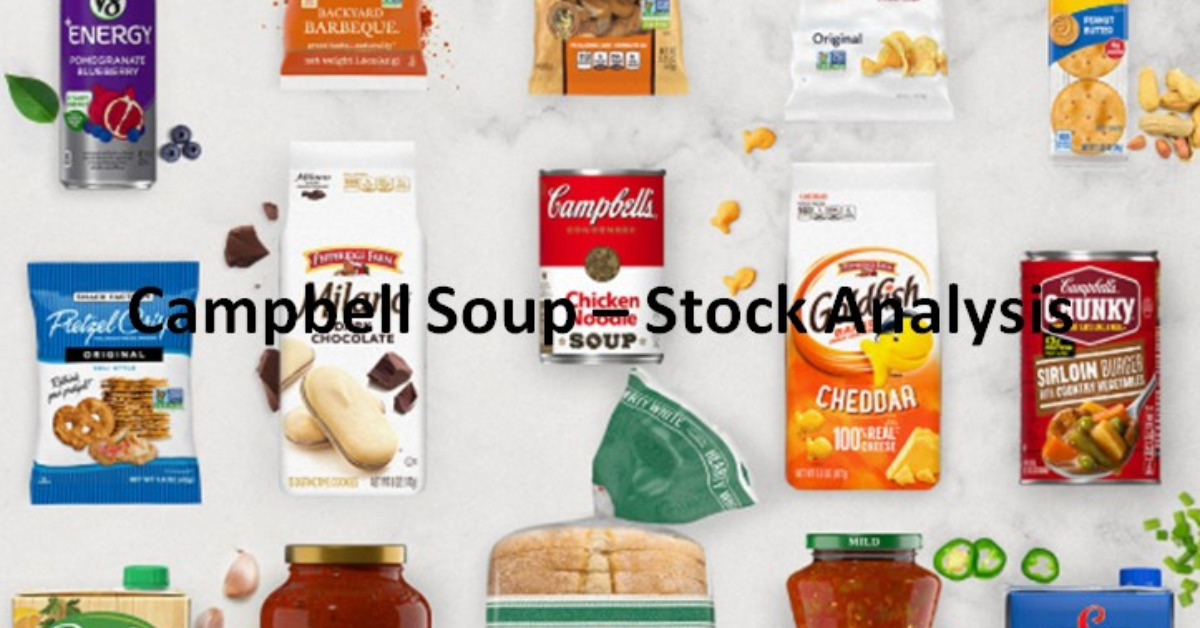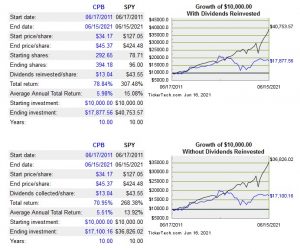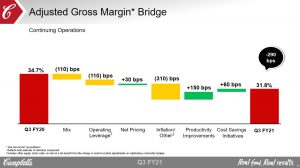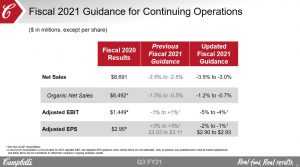Contents
Campbell Soup's enticing dividend yield might tempt some investors. Investing on the basis of a stock's dividend yield is, in my opinion, flawed. Investors would be wise to analyze a company based on overall potential investment return. In this Campbell Soup stock analysis, I conclude this is a company to avoid.
I do not base my investment decision on a company's historical performance. I do, however, look at the historical returns to get a sense of the extent to which a company has rewarded shareholders.
In the case of CPB, the historical performance is abysmal.
Information Sources
The following are links to my sources to aid in your own analysis.
Part 1 of the FY2020 10-K has a good overview of CPB's industry, customers, business strategy, solutions and risks. Additional information is also available in the:
Campbell Soup - Stock Analysis - Business Overview
Most people are undoubtedly familiar with CPB. While it organized as a business corporation in November 1922, we see from its history that, through predecessor organizations, it traces its heritage in the food business to 1869.
CPB consists of 2 reportable segments:
- Meals & Beverages
- Snacks.
Most of their brands are recognizable names.
CPB has been struggling for several years. To improve business results, the company has been divesting itself of business segments deemed to be non-core.
It operates in a highly competitive industry. Competition arises from numerous competitors of varying sizes across multiple food and beverage categories. This includes producers of private label products, as well as other branded food and beverage manufacturers. Private label products are generally sold at lower prices than branded products and private label products have, generally, been eroding the market share of branded product manufacturers.
The FY2020 10-K is a great source of information to quickly learn about the company.
Campbell Soup - Stock Analysis - Financials
Q3 and YTD2021 Results
On June 9, 2021, CPB released Q3 and YTD results and FY2021 guidance.
Management reports CPB's results as being negatively impacted by:
- a rising inflationary environment;
- short-term increases in supply chain costs; and
- pressures to execute as it continues its transformation agenda.
In Q3, CPB generated sales of $1.98B. This was in line with management's expectations. Sales results benefited from the continued momentum of the Snacks power brands and US retail products in the Meals & Beverage division. There are also early signs of recovery from the foodservice business.
Nearly three-quarters of the portfolio experienced gains or held market share in Q3 with most core categories having grown at higher rates than pre-pandemic levels.
The following image reflects the various components that have contributed to the 290 bps erosion in CPB's gross margin relative to Q3 2020.
FY2021 Guidance
Management anticipates Q4 2021 organic sales will decline versus Q4 2020.
CPB reports pronounced inflation that is primarily related to much higher transportation costs. Pricing actions have been put in place across the portfolio and productivity plans have been introduced to mitigate this inflation pressure in FY2022.
Operating Cash Flow (OCF) Free Cash Flow (FCF)
CPB has divested itself of various segments of its business. This reduces the relevancy of historical OCF and FCF results.
YTD cash flow from operations decreased from $1.125B in Q3 2020 to $0.881B in Q3 2021 (page 6 of 43 in the Q3 10-Q). This is primarily due to changes in working capital, principally from lower accrued liabilities and lapping significant benefits in accounts payable in the prior year.
YTD cash for investing activities was largely reflective of $0.19B of CAPEX cash outlay. This $30 million reduction from $0.22B in Q3 2020 is primarily driven by discontinued operations.
YTD cash outflows for financing activities were $1.4B, reflecting a $0.327B dividend cash outlay.
Short-term and long-term debt repayment slightly exceeds $1B. This is in keeping with management's efforts to reduce leverage. Management is committed to deleveraging and CPB investors would be wise to monitor how this is progressing.
Campbell Soup - Stock Analysis - Credit Ratings
CPB is a company whose long-term unsecured credit rating has been cut 8 notches in a span of ~20 years!
In July 1990, Moody's cut CPB's Aaa credit rating 2 notches to Aa2; Moody's now assigns a Baa2 rating. This rating is the middle tier of the lower medium grade and is 2 notches above non-investment grade speculative.
S&P assigns a BBB- rating which is one notch lower than the rating assigned by Moody's.
Fitch assigns a BBB rating which is the same level as the rating Moody's assigns.
All 3 ratings define CPB as having an ADEQUATE capacity to meet its financial commitments. However, adverse economic conditions or changing circumstances are more likely to lead to CPB having a weakened capacity to meet its financial commitments.
I am also concerned that in August 2008, Moody's upgraded CPB's rating to A2 from A3 but in late 2014, the rating was once again cut to A3. This rating was subsequently cut 2 notches to Baa2 in early 2018.
Although I invest in companies with similar ratings as those assigned to CPB, the deteriorating trend together with several other factors leads me to conclude this is not a company in which I am prepared to invest.
Dividend and Dividend Yield
CPB currently distributes a $0.37/share quarterly dividend. On an annualized basis, the $1.48 dividend yields ~3.25% based on a ~$45.45 share price.
Investors who fixate on dividend yield may be tempted to invest in CPB. An attractive dividend yield, however, is an insufficient reason to invest in this company.
Furthermore, if we look at the dividend history we see that regular dividend increases can not be relied upon.
CPB has not had any stock split since 1997.
On the weighted average shares outstanding front, CPB's share count in FY2011 - Fy2020 is 329, 319, 317, 316, 313, 311, 307, 302, 302, and 304 (millions of shares).
In March 2017, CPB's Board authorized a $1.5B share repurchase program with no expiration date. In addition, the Board authorized to purchase shares to offset the impact of dilution from shares issued under its stock compensation plans. CPB suspended its share repurchases as of Q2 2018.
The Consolidated Statement of Cash Flows shows that CPB repurchased $0.24B, $0.143B, $0.437B, and $0.86B in FY2015 - 2018. The average price paid per share was much higher than the current ~$45.45 share price. The act of repurchasing these shares essentially destroyed shareholder value.
Campbell Soup - Stock Analysis - Valuation
CPB's earnings are muddied in that we have to account for discontinued operations. I, therefore, use adjusted earnings management provides to gauge CPB's valuation.
In the first 3 quarters of FY2021, CPB reports adjusted diluted EPS of $2.43 versus $2.34 over the same period of the prior fiscal year.
FY2021 adjusted diluted EPS guidance has been lowered from $3.03 - $3.11 to $2.90 - $2.93; CPB reported adjusted diluted EPS of $2.95 in FY2020.
Using the current ~$45.45 share price, the forward adjusted diluted PE range is ~15.51 - ~15.67.
Guidance from the 17 brokers which cover CPB is fairly wide-ranging.
- FY2021 adjusted diluted EPS is a mean of $2.92 and a $2.86 - $3.07 range. With shares trading at ~$45.45, the forward adjusted diluted PE is ~15.57 using the mean value.
- FY2022 adjusted diluted EPS is a mean of $2.91 and a $2.70 - $3.14 range. With shares trading at ~$45.45, the forward adjusted diluted PE is ~15.62 using the mean value.
Despite the attractive valuation, CPB faces considerable headwinds. Investors would be wise to consider that CPB has a low valuation for a reason!
Campbell Soup - Stock Analysis - Final Thoughts
As much as CPB might be attractively valued, this company is struggling.
In my opinion, the attractive ~3.25% dividend yield is no basis upon which to invest in CPB; there are far better companies that carry far less risk and which have superior growth potential.
I have no intention of initiating a position.
Stay safe. Stay focused.
I wish you much success on your journey to financial freedom!
Note: Please send any feedback, corrections, or questions to [email protected].
Disclosure: I do not have exposure to CPB and do not intend to initiate a position within the next 72 hours.
Disclaimer: I do not know your individual circumstances and do not provide individualized advice or recommendations. I encourage you to make investment decisions by conducting your own research and due diligence. Consult your financial advisor about your specific situation.





